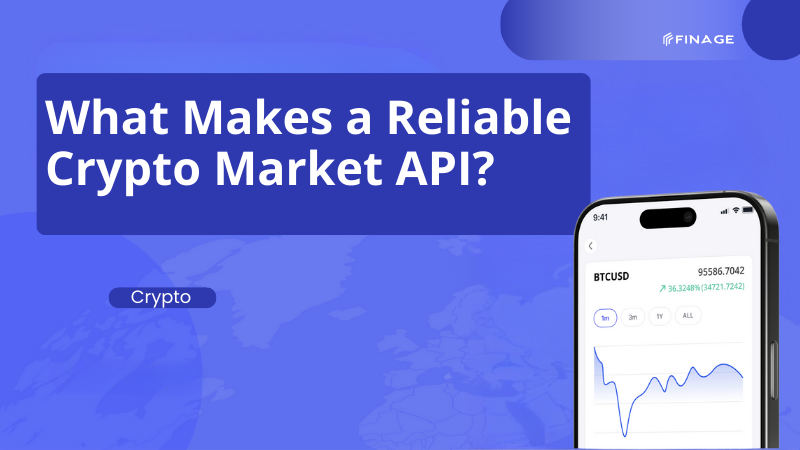How Currency Spreads Impact Your Forex Algo: Real-World API Use
9 min read • June 30, 2025

Introduction
Forex trading algorithms rely on precision. Millisecond decisions, accurate pricing, and fast order execution are all part of the equation—but one factor can quietly erode profitability if ignored: currency spreads. Whether you’re building an arbitrage engine or a smart order router, failing to account for spread dynamics can turn your winning model into a losing one.
Spreads aren’t static. They widen during volatility, compress during high liquidity, and vary depending on the pair, time of day, and market sentiment. That means your algo needs more than just price—it needs real-time, spread-aware data to make informed decisions.
This post explores how spreads impact trading logic, how to track them using real-time market data, and how Finage APIs can help developers design smarter, more adaptive Forex trading strategies.
Looking to integrate spread-aware logic into your FX tool? We’ll break down the API side of it—no guesswork required.
Table of Contents
- What Are Currency Spreads and Why Do They Matter?
- Spread Sensitivity in Algorithmic Forex Trading
- Monitoring Real-Time Spreads with Finage APIs
- Common Mistakes When Ignoring Spread Dynamics
- Best Practices for Spread-Aware Algo Design
- Streaming Spreads via Finage WebSocket API
- Final Thoughts
1. What Are Currency Spreads and Why Do They Matter?
In Forex trading, the spread is the difference between the bid price (what buyers are willing to pay) and the ask price (what sellers are asking). It represents the cost of entering and exiting a position—often small in liquid pairs, but always present. Even tiny spreads can significantly affect high-frequency or high-volume strategies.
For example, if EUR/USD is quoted as 1.1045 (bid) / 1.1047 (ask), the spread is 2 pips. If your algorithm enters a buy position at 1.1047 and exits at 1.1045 without accounting for that gap, it absorbs a 2-pip loss before slippage or fees are even considered.
Spreads are affected by:
- Market liquidity: Tighter during major trading sessions (e.g., London or New York open)
- Volatility: Widen during news events or geopolitical uncertainty
- Currency pair type: Majors like EUR/USD have smaller spreads; exotic pairs can be much wider
- Broker model: ECN vs market maker execution models affect how spreads are sourced
Many trading models assume spreads are fixed or negligible—but this assumption is dangerous. In reality, they fluctuate and can spike unexpectedly, especially during off-hours or macroeconomic events. Ignoring this can lead to negative trade performance, even if your entry logic is sound.
That’s why monitoring live spread data through an accurate feed—like the one offered in Finage’s Forex API—is essential. It allows you to calculate true execution cost and build strategies that respond dynamically to market conditions.
Spreads are more than a footnote—they're a key part of any trading algorithm’s performance.
2. Spread Sensitivity in Algorithmic Forex Trading
Algorithmic trading thrives on patterns, but spreads introduce friction that can distort even the best strategies. When left unaccounted for, they quietly chip away at profits—or worse, turn positive trades into consistent losses.
Let’s say your algo is designed to capitalize on micro price movements—buying low and selling slightly higher, dozens of times per day. If the spread is wide, many of those “profitable” signals won’t cover the cost of entering and exiting the position. This effect is even more pronounced in scalping or high-frequency models.
Spreads also fluctuate in response to real-world events. Your algorithm might work flawlessly during stable market hours but underperform around economic announcements or geopolitical tension, simply because the spread widens beyond your risk tolerance. A strategy that doesn’t react to these shifts can misfire repeatedly.
Another key challenge is backtesting. If your historical data doesn’t include spreads, you may be overestimating profitability. Many datasets offer mid-prices or closing prices only—fine for analysis, but not for simulating real-world trade execution.
By using real-time spread data from a source like Finage Forex API, developers can build smarter entry filters. You might, for instance, block trades during spread spikes, switch to wider-tolerance logic, or alert users when conditions are unfavorable.
A profitable algorithm isn’t just accurate—it’s aware. Spread sensitivity separates naive models from production-ready engines.
3. Monitoring Real-Time Spreads with Finage APIs
To build spread-aware trading systems, you need access to bid and ask prices in real time—ideally from a reliable, low-latency source. Finage makes this process straightforward through its Forex API endpoints, which provide direct visibility into live market pricing across currency pairs.
Instead of relying on a single “last price,” the Finage API delivers:
- Bid price: The highest price a buyer is currently willing to pay
- Ask price: The lowest price a seller is willing to accept
- Timestamp: Accurate to milliseconds, ensuring the quote is fresh
- Symbol-based endpoints: So you can monitor only the pairs your algo trades
With these values, your system can calculate the current spread on each tick—no guesswork or midpoint estimation needed. This opens the door to custom logic based on spread behavior, such as:
- Avoiding trades when spreads exceed a certain threshold
- Dynamically sizing positions based on spread risk
- Adjusting stop-loss or take-profit values in volatile conditions
- Logging spread volatility for performance diagnostics or audits
For developers running multiple strategies across different pairs, Finage’s consistent data formatting means you can normalize spread logic across EUR/USD, GBP/JPY, or even exotic pairs without needing to rewrite your parsing code.
To achieve the lowest latency, many apps combine REST-based polling (for initial sync) with WebSocket subscriptions for live spread updates. This allows for both precision and efficiency in monitoring.
Tracking spreads in real time isn’t just a nice-to-have—it’s the foundation for executing smart, risk-adjusted trades in the FX market.
4. Common Mistakes When Ignoring Spread Dynamics
Spread-related errors often go unnoticed until it's too late—until a strategy starts bleeding capital despite clean backtests or well-defined signals. Ignoring the spread can lead to flawed assumptions that break down in real market conditions.
Here are some of the most common mistakes:
Using mid-price for execution logic
Many developers rely on average or midpoint prices (bid + ask / 2) for entry and exit conditions. While useful for charting, mid-prices don’t reflect actual execution. Your algo might enter thinking the market is at 1.2050 when in reality, it's buying at 1.2052 and selling at 1.2048—a 4-pip swing.
Backtesting without accounting for spread
Strategies that look great in historical simulations can fall apart in production if the spread is excluded. A model that assumes zero spread will overstate returns and underestimate risk.
Trading during low-liquidity periods
Spreads typically widen during off-hours, weekends, or holidays. Algos that operate 24/7 without filtering for spread size can unknowingly take unfavorable trades during thin markets.
Ignoring spread spikes during news events
Macroeconomic releases, central bank speeches, or unexpected headlines can cause spreads to widen instantly. If your system trades based solely on price signals, it may jump into poor positions without realizing execution costs have temporarily surged.
Applying one-size-fits-all thresholds
Not all pairs behave the same. EUR/USD may have a tight 1-pip spread, while exotic pairs like USD/ZAR can regularly exceed 10 pips. Spreads should be evaluated pair-by-pair.
With Finage, accessing real bid-ask pricing data in real time helps avoid these issues before they hit your live account. By integrating accurate spread tracking into both backtests and live trading, you protect your models from false signals and inflated expectations.
Spread-blind algos often look brilliant on paper—but fragile and expensive in production.
5. Best Practices for Spread-Aware Algo Design
Designing a Forex trading algorithm that accounts for spreads isn't just about avoiding losses—it's about gaining a more accurate view of market behavior. A spread-aware approach ensures that your model operates based on the true cost of each trade and adapts in real time to market conditions.
Start by making spread a first-class data point. Just like you track price, volume, or momentum, your system should track current spread values per symbol. Whether you’re using Finage’s REST endpoints or WebSocket feeds, this gives your model a live picture of execution costs.
Here are several techniques to implement:
- Include spread buffers in all trade signals: Don’t trigger trades on raw price thresholds. Require that expected profit exceeds the current spread by a reasonable margin.
- Block or delay trades during wide-spread periods: For example, if the spread exceeds a volatility-adjusted threshold, pause trading or reduce position size.
- Adapt take-profit and stop-loss distances dynamically: Spreads affect both entry and exit prices—your system should account for that when setting targets.
- Log spread data for strategy reviews: Tracking spread alongside performance can help identify patterns, inefficiencies, or ideal trading hours.
Most importantly, be sure your backtesting engine uses live bid/ask history, not just close or mid-prices. Without this, your historical results won’t reflect the real-world challenges your system will face.
Finage offers consistently formatted Forex API endpoints that support this level of control and insight. Integrating them helps ensure your algo is grounded in reality—not assumptions.
Treating spread as noise is a mistake; treating it as a variable makes your algorithm stronger.
6. Streaming Spreads via Finage WebSocket API
To stay competitive in algorithmic Forex trading, latency matters. Spreads change quickly—sometimes in fractions of a second—so relying solely on REST polling can leave your algorithm behind the market. For real-time execution and accurate spread tracking, streaming is the better choice.
Finage’s WebSocket API provides direct access to live bid and ask prices for currency pairs. Once connected, your app receives updates as soon as they happen, allowing you to:
- Monitor spread fluctuations tick-by-tick
- React instantly to volatility or market shocks
- Implement time-sensitive rules, such as “pause trading when spreads widen by X% within 5 seconds”
- Keep your UI synced with real-time execution conditions
Each WebSocket message includes timestamped bid and ask prices for subscribed pairs. This enables your backend to calculate the live spread continuously and evaluate whether trading conditions are acceptable.
For strategies that scale across many pairs, Finage’s efficient messaging system ensures you can stream only the data you need. This reduces load while maintaining full visibility into the Forex market’s most fluid data points.
Some developers also combine WebSocket feeds with REST-based monitoring to catch edge cases (e.g., API reconnects, post-trade reconciliation, historical snapshots). Finage supports both methods seamlessly within the same ecosystem.
Streaming spreads is how you future-proof your algo against latency, slippage, and poor execution timing.
7. Final Thoughts
In Forex algorithmic trading, precision isn’t optional—it’s the core of every decision your system makes. And at the heart of that precision is spread awareness. Whether you’re running a high-frequency model or a swing strategy, spreads directly impact execution quality, profitability, and risk.
Ignoring them distorts reality. Accounting for them brings your logic in line with the real market.
With Finage, you can stream live bid/ask prices across major and minor currency pairs, monitor spread behavior in real time, and build systems that adapt to changing conditions. You’re not just collecting data—you’re creating an edge.
Use the Forex Data API to monitor spreads, and integrate the WebSocket stream to power latency-sensitive strategies. Every pip matters—and with the right data, you can account for every one of them.
Spreads aren’t noise—they’re a signal. And they’re a signal your algorithm can’t afford to miss.
Claim Your Free API Key Today
Access stock, forex and crypto market data with a free API key—no credit card required.

Stay Informed, Stay Ahead
Finage Blog: Data-Driven Insights & Ideas
Discover company news, announcements, updates, guides and more


